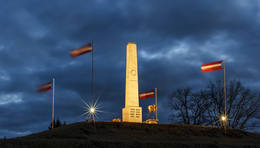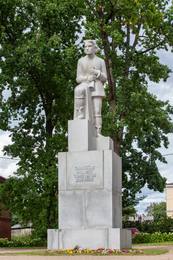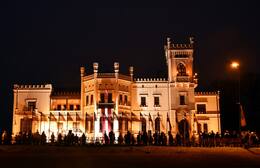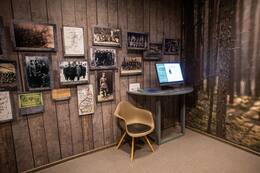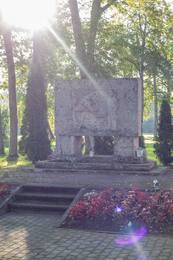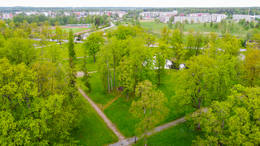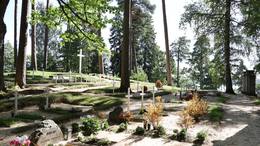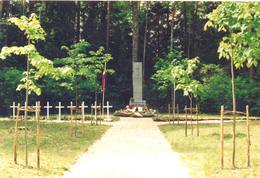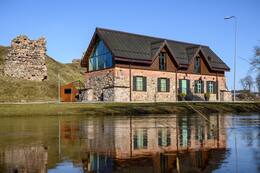7-asis Siguldos pėstininkų pulkas
I Nepriklausomybės karai
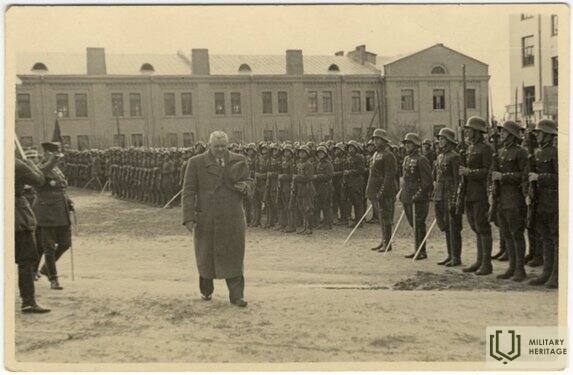
Lemiamo Cėsių mūšio išvakarėse, 1919 m. birželio 20 d., pulkininko Jorgio Zemitano įsakymu, sujungus Šiaurės Latvijos brigados Rūjienoje ir Naukšėnuose atsargos batalionus, buvo suformuotas 3-asis Jelgavos pėstininkų pulkas, kuris buvo pervadintas į 7-ąjį pulką2 Siguldos mūšio rugpjūčio mėn. Pirmasis šio dalinio vadas buvo pulkininkas leitenantas Oskars Dankers. Pulkas buvo priskirtas Latgalos divizijai.
Po formavimo pulkas geležinkeliu buvo nugabentas į Taliną (Rėvelį), kur birželio 29 dieną gavo 500 šautuvų ir britų karinio jūrų laivyno kreiseriu „Dragon“ ir 2 minų klojiniais buvo nugabentas į Liepoją, kur buvo dislokuotas Kara Osta kareivinėse. 6 turas 07.25 d. išsiųstas į Ventspilį, 2-oji kuopa liko Liepojoje.
7-asis Siguldos pėstininkų pulkas dalyvavo mūšiuose su Bermonto kariuomene ir išlaisvinant Šiaurės Latgalą. Pulko kariai dalyvavo daugelyje mūšių, tarp jų Katlešių, Vecumio ir Purvmalos stotyse, taip pat Jaunlatgalės ir Augšpilio išvadavime. Nepriklausomybės kovų metu krito arba nuo žaizdų mirė 116 pulko karių, 79 dingo be žinios. Lāčplėsio karo ordinu apdovanoti 85 pulko kariai.
Pasirašius Latvijos ir Rusijos taikos sutartį, pulkas liko Rytų pasienyje (Rėzeknėje), kur saugojo sieną nuo Rītūpės stoties iki Estijos sienos, kol atvyko pasieniečių daliniai. 1921 metų sausį pulkas buvo perkeltas į Alūksnės ir Gulbenės apylinkes. Tų pačių metų balandžio 1 d. pulkas buvo pertvarkytas pagal taikos meto statusą. 1923 metais Alūksnėje buvo pastatytos pirmosios dviaukštės kareivinės, o 1929 metais – antrasis trijų aukštų kareivinių pastatas. 1935 metais Gulbenėje buvo dislokuotas 11-ojo Dobelės pėstininkų pulko batalionas, kuris į pulką įtrauktas kaip ketvirtasis batalionas, todėl 7-asis Siguldos pėstininkų pulkas tapo didžiausiu Latvijos kariuomenės pulku.
1940 metais po sovietų okupacijos 7-asis Siguldos pėstininkų pulkas buvo išformuotas rugsėjo 10 d. Kariai buvo priskirti SSRS Raudonosios armijos 24-ojo teritorinio šaulių korpuso 285-ajam šaulių pulkui.
Daugiau informacijos šaltinių
Siguldos pulkui atminti. 1919. 20.- VI 1959. Siguldos pulko memorialinis fondas, Linkolnas, 1959.- 231 p.
Oskaras Dunkeris. Kaip tapau 7-ojo Siguldos pulko įkūrėju ir pirmuoju pulko vadu. Straipsnių rinkinys: Ziemeļnieki II, 1974.- http://www.periodika.lv/periodika2-viewer/view/index-dev.html#panel:pp|issue:/g_001_0306121295|straipsnis:DIVL839|issueType:undefined
7-asis Siguldos pėstininkų pulkas – 100 SARGS.LV 2019-06-19. https://www.sargs.lv/lv/vienibas-un-personibas/2019-06-19/7-siguldas-kajnieku-pulkam-100
Susijusi laiko juosta
Susijusios vietos
Monument to the soldiers of the 7th Sigulda Infantry Regiment who died in the Latvian War of Independence
Located on the shores of Lake Alūksne, on the edge of Pleskavas Street (Kolberg Road).
On June 22, 1923, the President of Latvia, Jānis Čakste, unveiled a monument to the fallen soldiers of the 7th Sigulda Infantry Regiment. The monument is based on the design of the artist Jūlijs Miesnieks.
The soldiers of the regiment also improved and maintained the area around the monument. Soldiers gathered at the monument on the eve of the regiment's annual holiday, when the holy fire was lit, as well as on the day of the regiment's year after the parade and intercession in the garrison cemetery.
1940/1941 The Bolsheviks removed and destroyed the plaque in 1953, but the monument itself was demolished in 1953 and its stones were laid in the foundations of the corner of the barracks house.
At the beginning of the Awakening, in the autumn of 1989, the vicinity of the destroyed monument, which was still in the territory of the USSR occupation forces, was cleaned up. On November 11, a temporary granite memorial was unveiled at the former location of the monument, with the text: "The monument of the 7th Sigulda Infantry Regiment will be restored in this place on November 11, 1989."
Thanks to the initiative of U. Veldre, the head of the Alūksne Brothers Cemetery Committee, the restoration of the monument was started and on October 16, 2009 the restored monument was unveiled.
Unlike the original monument, a cross was created on the obelisk regiment instead of a chest sign. Both sculptures of the monument were wrought by the sculptor Ainars Zelcs. Both the part of the 22 original obelisk blocks found on the territory of the National Armed Forces Infantry School and the newly built blocks were used for the restored monument.
On June 20, 2019, as part of the centenary of the Sigulda Infantry Regiment, a memorial site and a granite memorial plaque to the fallen soldiers of the unit were unveiled at the foot of the monument hill. The memorial site was built with funds donated by the staff of the Infantry School of the National Armed Forces.
Paminklas „Talavos trimitininkas“
Located in Rūjiena Center Square.
The three-meter-high image of an ancient Latvian guardian carved in gray Finnish granite, called the “Tālava trumpeter”, is placed on a three-meter-high granite pedestal, but the total height of the monument reaches 7.5 meters. In the initial sketches and models, K. Zemdega had placed a sword in his hands, which was later replaced by a trumpet. The monument was unveiled on August 15, 1937.
This monument reflects the difficult situation in the formation of our country and army, as well as in the assessment of these events. Immediately after the proclamation of the Latvian state, the Red Army invaded and the interim government of Kārlis Ulmanis established a refuge in Liepāja. In February 1919, with the help of the Estonian army, the liberation of Latvia from the north began and the first mobilization took place in the Rūjiena area for the Latvian troops formed in Tartu, which became the Northern Latvian Brigade under the command of Colonel Jorgis Zemitans. The Northern Latvian brigade fought not only against the Bolsheviks, but also against the Landeswehr and Iron Division in the battles of Cēsis. The soldiers of Northern Latvia, mobilized in the vicinity of Rūjiena, also fought in the subsequent battles for the War of Independence. After the war, the main laurels were won by General Jānis Balodis and the Southern Latvian Brigade he commanded, but he often forgot about the Northern Latvian Brigade. The monument to Rūjiena, which was planned in Rūjiena, was built for a long time, and the monument, unveiled in 1937, was officially popularized as a monument to the liberation of Rūjiena and the memory of fallen soldiers, not to mention the beginning of all regiments in Northern Latvia.
The monument is not only a popular sight for Latvian and Estonian tourists, which is to some extent a starting point for visiting several other places of remembrance of the War of Independence in Rūjiena, but "Tālavas taurētājs" is also a stopping place for Estonian and Latvian officials of various levels.
The monument to the liberation and fallen soldiers of Rūjiena, more commonly known as the “trumpet of Tālava”, was included in the list of cultural monuments protected by the state as an art monument of national significance on October 29, 1998 (monument protection registration number 4522).
Alūksne Museum
The Alūksne Museum is located in an architectural monument of national significance: the neo-Gothic Alūksne New Castle built in the late 19th century. The museum features an exhibition named ‘Memorial Room for Victims of the Totalitarian Regime’, which tells about the fate of the inhabitants of Alūksne municipality in Siberia and the Far East, while the time periods from prehistory to the present meet in the Alūksne history exhibit ‘Feast of the Ages’. It features a separate section devoted to the contribution of the 7th Sigulda Infantry Regiment to the military, culture and public life. The formation of the 7th Sigulda Infantry Regiment began on 20 June 1919 in the Naukšēni Manor. Initially, a battle group of 22 officers and 1,580 soldiers was formed from the reserve battalion of the Northern Latvian Brigade, and was named the Dankers Division. It was included in the 2nd Battalion of the 3rd Jelgava Regiment. On 23 August, following an increase in the number of companies, it became part of the 7th Sigulda Infantry Regiment. Having taken part in the battles against Bermondt, on 5 January 1920, the regiment was transferred to the Latgale front to fight the Bolsheviks. After the signing of the Peace Treaty with Soviet Russia, the regiment guarded Latvia’s eastern border. The Latvian War of Independence saw the deaths of more than 200 soldiers of the regiment, while 85 were awarded the Lāčplēsis War Order. In 1921, the 7th Sigulda Infantry Regiment was stationed in Alūksne. The regiment’s headquarters were set up in the Alūksne New Castle. After World War II, the castle was taken over by Soviet security institutions. As of the late 1950s, the castle housed various cultural institutions: the Culture and Cinematography Department of the Executive Committee, a pioneer house, a library, a cinema and a museum.
Ekspozicija „Šiaurės Latgala kovose už laisvę“ (Ziemeļlatgale brīvības cīņās)
Muziejus įsikūręs Balvų dvaro komplekse, buvusiame dva ro klėties pastate. Ekspozicija supažindina su Latvijos Nepriklausomybės kovų istorija iš Šiaurės Latgalos perspektyvos, pasakoja Latgalos partizanų pulko kūrimosi ir veiklos istoriją. Čia eks ponuojamos anksčiau niekur nepublikuotos nuotraukos ir dokumentų kopijos, įskaitant 1919 m. liepos 5 d. įsakymą dėl pulko suformavimo. Ypatingą ekspozicijos dalį sudaro 1919 m. liepos–spalio mėn. rusų kalba rašyti vidiniai pulko įsakymai. Jie atskleidžia šio vietinio karinio dalinio forma vimosi ypatumus – jame kartu kovojo latviai, latgaliai, ru sai ir žydai. Tik pulkui tapus visaverte Latvijos kariuomenės dalimi ir jį papildžius mobilizuotiems kariams iš kitų Latvijos regionų, vidiniai dokumentai pradėti rengti latvių kalba. Ekspozicijoje pasakojama apie Šiaurės Latgalos išvadavi mo operaciją. 1920 m. sausio 9–15 d. Latvijos kariuome nės Latgalos divizijos vykdytų mūšių metu buvo išlaisvintos Viliakos, Jaunlatgalės ir Karsavos apylinkės. Galima apžiū rėti su šia operacija susijusius eksponatus, įskaitant ir Lat galos partizanų pulko veiklą Karsavos išvadavimo metu.
Monument to the liberators of Northern Latvia
Located in the center of Placa by the Inčukalns - Valka highway (A3). Next to the bus stop and Straupe People's House.
The monument made by Teodors Zaļkalns to the liberators of Northern Latvia in 1919 at the Battle of Cēsis can be seen.
There are two limestone supports on the three-step base, on which the limestone block rests. In front of it, the lower part depicts a horse harnessed to a plow and a plow holding reins in his right hand and a sword in his left. A text engraved on the back of the monument, closed by lines by the poet Eduards Virza:
FOR THE RELEASES OF NORTHERN LATVIA
WHILE THE CEREALS ARE SEED IN THESE FIELDS
YOU WILL BE GLORIFIED AND HONORED
The monument was unveiled on November 8, 1931. President Alberts Kviesis took part in the opening.
Latvian military aviation aerodrome
Located in the territory of Vecgulbene manor - in the historical center.
In the interwar period, the garrison of the Latvian Army was located in Gulbene, where the 7th Sigulda Infantry Regiment Battalion was stationed. Aerodromes are especially important in places where important railway and road junctions have been established. In 1937, a newly established unit of the Aviation Regiment was stationed in Gulbene, which became the 6th Division of the Latgale Division Scouts, increasing the number of army units near the eastern border of Latvia.
The conservatory building is visible.
Alūksne Garrison Cemetery
Located on the shores of Lake Alūksne, on the Kapsēta peninsula, in the territory of the Great Cemetery.
They were started and maintained by the soldiers of the 7th Sigulda Infantry Regiment in the 1930s and consecrated on November 11, 1932. After the restoration of Latvia's independence, Uldis Veldre, the head of the department of the Alūksne Brothers' Cemetery Committee, took care of the maintenance of the Garrison Cemetery, the identification of the resting places associated with Alūksne and the installation of memorials in the Garrison Cemetery.
Military personnel of the Army of the Republic of Latvia were buried in the garrison cemetery, as well as soldiers and civilians killed in the fight against the Bolsheviks on July 4, 1941 in Alūksne near Jāņkalniņš and on July 7, 1941 in Ziemera parish.
Most of the buried have white wooden crosses with metal plaques, which indicate the name of the deceased, the rank or occupation, as well as the date of birth and death.
On December 19, 1990, a memorial to Vilius Spandeg, a knight of the Lāčplēsis Military Order, was unveiled in the Garrison Cemetery. Standard memorial plaques were also erected to the LKOK, who died or were killed in communist concentration camps and were not buried in Latvia. On November 11, 1990, a memorial was erected to Voldemārs Zaķis, who died in the communist concentration camp.
Karvas Brothers Cemetery
It is located on the side of Alūksne - Ape road near the Eel House, south of Karva, turning to Rezaka.
The monument was unveiled on September 12, 1937. The granite stencil was designed by Oem Dambekalns in Riga in Riga by the architect Vemera Vitand.
In the autumn of 1975, the local communists destroyed the monument. On March 30, 1989, the Alūksne District Council decided to restore the monument, and on April 30, 1989, a temporary wooden memorial in the form of a Latvian tombstone was erected by Jānis Jaunzems, a worker at the State Electrotechnical Factory (VEF). It read: "The monument to the Karvas Brethren will be restored here."
At that time, the adjacent Brothers' Cemetery was also improved.
In 1993, thanks to the initiative of Uldis Veldre, the head of the Alūksne Brothers' Cemetery Committee, the restoration of the memorial site resumed. The new monument was made by Cēsis stonemason brothers Aivars, Austris and Auseklis Kerliņi.
The monument was unveiled on June 11, 1994.
Four soldiers of the 5th Company of the Valmiera Infantry Regiment are buried in the Brothers' Cemetery - Jēkabs Sukse, Pēteris Leitlands, Ernests Puķītis and Gustavs Ozols, who died on April 2, 1919 in the battles at the Eel House. Roberts Grazer, a soldier of the Valmiera Regiment, was buried as the fifth soldier of the Valmiera Regiment in the mid-1930s, and disappeared on March 31, 1919 at the New Manor. Initially, he was buried as an unknown, but later the name was found and carved into the monument. Augusts Dzedons (Ziedons), the fifth soldier who died in the Battle of Eel, was buried in the Apekalns cemetery.
A memorial plaque has been erected at the foot of the monument to Jānis Goldem (1891–1952), a participant in the eel battle in LKOK, who died in the Communist concentration camp in Inta, Komi.
The second memorial plaque, unveiled on August 23, 1992, was erected at one of the wooden crosses and is dedicated to Corporal Peter Janson of the 7th Sigulda Infantry Regiment, who was assassinated by the oncoming communists on July 7, 1941.
Laisvosios valstybės brangenybių namai
Nepriklausomos valstybės palikimą saugantys namai yra šalia Rėzeknės pilies griuvėsių.
Išskirtinėje ekspozicijoje pristatoma keli šimtai istorinių eks ponatų iš Latvijos ir užsienio privačių kolekcijų, apimančių 1918–1940 m. laikotarpį, bei skirtingus Latgalos ir Rėzeknės istorijos puslapius. Supažindinama su Pirmosios nepriklau somos Latvijos valstybės karinių ir civilinių apdovanojimų istorija, įvairių valstybinių ir visuomeninių organizacijų vei kla, vykusia nuo Latvijos nepriklausomybės karo iki Antrojo pasaulinio karo.
Tai didžiausia Latvijoje kolekcija, pristatanti nepriklausomos valstybės karinius ir civilinius apdovanojimus bei skiriamuo sius ženklus. Antrajame aukšte įrengta keičiamų parodų salė, kurioje bent kartą per metus surengiama nauja paroda.
Lankyto jai jau turėjo galimybę pamatyti išskirtinę porceliano dirbi nių kolekciją, prabangius laikrodžius iš Prancūzijos ir įvairius Latgalos peizažus vaizduojančius paveikslus
Susijusi istorija
7. Siguldos pėstininkų pulko formavimas
1919 m. birželio 20 d. Naukšėnų dvare, Rūjienos apylinkėse, pagal Šiaurės Latvijos brigados vado pulkininko Jorgio Zemitano įsakymą pradėtas formuoti 7-asis Siguldos pėstininkų pulkas. Iš pradžių iš Šiaurės Latvijos brigados rezervinio bataliono buvo suformuota nedidelė kovinė grupė, kurią sudarė 22 karininkai ir 1580 karių, kuri pirmojo vado Oskaro Dankerio garbei buvo pavadinta Dankerio divizija. Po kelių dienų dalinys buvo įtrauktas į 3-iojo Jelgavos pulko 2-ąjį batalioną, o rugpjūčio 23 d., papildžius kuopa, į 7-ąjį Siguldos pėstininkų pulką.
7-oji Siguldos pėstininkų pulko bermontiada, Didžiosios kunigaikštienės Valijos Veščūnos apdovanojimas Lāčplės karo ordinu Alūksnėje.
Po Latvijos nepriklausomybės karo didysis seržantas Valija Veščunas 1919 m. lapkričio 19 d. už kautynes su bermontininkais prie Plėnų namų buvo apdovanotas Lāčplės karo ordinu. Valija Veščunas viena pirmųjų perėjo Lielupę priešo ugnimi.
Atminimo akimirka Garnizono kapinėse
Atkūrus Latvijos nepriklausomybę Alūksnės brolių kapinių komiteto vadovas Uldis Veldre prisiėmė atsakomybę už Garnizono kapinių priežiūrą, su Alūksne susijusių LKOK poilsio vietų nustatymą, atminimo ženklų įrengimą Įgulos kapinėse.





